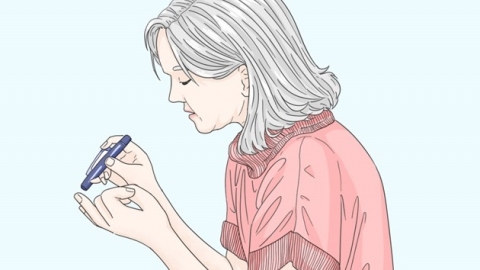What causes dark spots in the vision of diabetic patients?
In general, the presence of black shadows in the visual field of diabetic patients may be caused by posterior vitreous detachment, floaters, diabetic retinopathy, diabetic macular edema, or vitreous hemorrhage. The solution depends on the specific cause and requires prompt medical attention and treatment as directed by a physician. Details are as follows:

1. Posterior Vitreous Detachment: Long-term hyperglycemia in diabetic patients leads to metabolic abnormalities in the vitreous, accelerating vitreous liquefaction and posterior cortical atrophy. When the posterior vitreous cortex separates from the internal limiting membrane of the retina, it may pull on retinal vessels or produce floaters, resulting in a sensation of moving black shadows in the visual field, possibly accompanied by photopsia. No specific treatment is required, but regular fundus examinations are necessary to rule out retinal tears.
2. Floaters: Hyperglycemia accelerates collagen fiber liquefaction in the vitreous, causing opalescent collagen aggregates to suspend within the vitreous and cast shadows on the retina, forming black floaters, which may also appear as semi-transparent or gray-black moving particles. Psychological counseling is recommended to alleviate anxiety and avoid excessive eye strain.
3. Diabetic Retinopathy: Damage to the retinal microvascular endothelium leads to microaneurysms, hard exudates, and small hemorrhages. Blood entering the vitreous or in front of the retina may cause visual field obstruction, often accompanied by decreased vision. As directed by a physician, medications such as calcium dobesilate capsules, oral pancreatin, and compound thrombostasin capsules may be used to reduce plasma viscosity and relieve symptoms.
4. Diabetic Macular Edema: Hyperglycemia damages the inner retinal barrier, increasing vascular permeability and leading to fluid accumulation in the macular region, forming cystoid edema or lipid exudates. A dark area may appear in the central visual field, often accompanied by abnormal color vision. Under medical guidance, anti-inflammatory medications such as triamcinolone acetonide injection, dexamethasone tablets, and indomethacin enteric-coated tablets may be used.
5. Vitreous Hemorrhage: Rupture of retinal neovessels or fragile vessel walls may cause massive bleeding into the vitreous cavity. Red blood cells and their degradation products block light transmission, often accompanied by eye pain. Medications such as prednisone tablets, vitamin E soft gels, and alpha-lipoic acid tablets may be used under medical supervision to exert anti-inflammatory and antioxidant effects.
During treatment, it is important to follow medical advice, take medications regularly, and adjust lifestyle and dietary habits to promote recovery.
References:
[1] Chinese Diabetes Society. Guidelines for the Prevention and Treatment of Type 2 Diabetes in China (2020 Edition)[J]. Chinese Journal of Endocrinology and Metabolism, 2021.
[2] World Federation of Chinese Medicine Societies. International Clinical Practice Guidelines for Traditional Chinese Medicine: Diabetic Retinopathy[M]. Beijing: China Press of Traditional Chinese Medicine, 2020.







